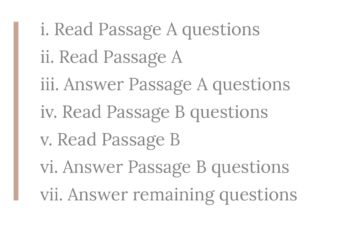Why ACT Reading and Science together? Because these sections are extremely similar. In fact, thinking of the ACT Science section as a reading comprehension test is a great way for students to get in a good frame of mind before taking the exam. Both sections are all about moving very quickly — sometimes skipping over the reading entirely — and gathering simple information from short passages. Both of these sections are also very teachable, so if your scores are currently a little underwhelming, don’t fret! Increases will come.
Reading
1. Questions first
We cannot stress this enough. For some test takers, this section is not nearly as difficult as SAT Reading, but the time crunch can be overwhelming. (Remember: step on it!) Regardless of whether you choose to annotate or not, having the questions in your head as you read will make you feel more purposeful.
2. According to … the passage indicates …
Questions that include these words will have the answer choices directly, explicitly in there. Word for word. “The Passage states…” questions will also be fairly explicit, but not necessarily verbatim. Find those answers in the passage. Do not go from memory. Always try to point to the place in the passage that shows your evidence.
3. The wrong answers will be wrong
As in, really wrong. Much more so than on the SAT. Actively look to cross out “garbage” in the answer choices until you have the least wrong answer. It may seem basic, but physically crossing out the “garbage” will literally help you see the right choice.
4. Be done with the passage in four minutes
You have about eight and a half minutes per passage here, which is fast. If you read the questions and then the passage itself in four minutes, you’ll leave yourself enough time to answer every question, even if it means having to skim.
Pro tip: Our biggest tip on the ACT Reading is skedaddle: move it or lose it! Move as fast as you can without losing your ability to comprehend what you are reading. Go, go, go!
5. Complete each paired passage individually
For the questions that ask you to compare both passages, your sequence should be as follows:

Science
1. Learn the different types of passages & timing strategies
Data Representation are almost exclusively data without any headings. There are two to three of these, and students should allot themselves five minutes for each.
Research Summary have headings that include, “Experiment 1, Experiment 2…” or “Study 1, Study 2…” Give yourself six minutes for these two to three passages.
Conflicting Viewpoints have headings that include, “Scientist 1, Scientist 2…” or “Student 1, Student 2.” There is exactly one of these. Allot yourself seven minutes to complete it.
2. Jump right to the first three questions
For Data Representations and Research Summaries, this strategy is a huge time saver and extremely effective. The first three questions on every passage (aside from Conflicting Viewpoints) will be exclusively graph, table, or logic-based and will not require any understanding of the passage itself.
3. Map the passage
When it comes time to mark the passage, pay attention to:
- Graph titles and identifiers
e.g., Figure 1, Figure 2, along with actual titles - Axes labels and scales
- Table headings
- Equations
- Trends in both tables and graphs
e.g., … as one variable increases, the other…
This will be where 80-90% of the questions on this section come from.
4. Conflicting viewpoints: read every word
It’s important to understand the key distinctions in the viewpoints fully, so read each viewpoint actively and, ideally, characterize that viewpoint in the margin with a very brief annotation. This will ultimately save you time and force yourself to assess your understanding. What’s implied? You do not have to read every word of the Data Representation and Research Summary passages. In fact, in many instances, you will not have to read any of the text. As a general rule, read those passages as needed. Do not read them before jumping down to the questions, as it will only confuse you.
5. You don’t need to be “a science kid”
As you may have heard, outside information is only a moderate requirement on this test. Kinetic and Potential Energy, pH, Chemical Equations, Punnett Squares, and Phases of Matter all come up fairly often. Know these, along with other basic biology, physics, and chemistry terms, but certainly do not study science in preparation for this test.


